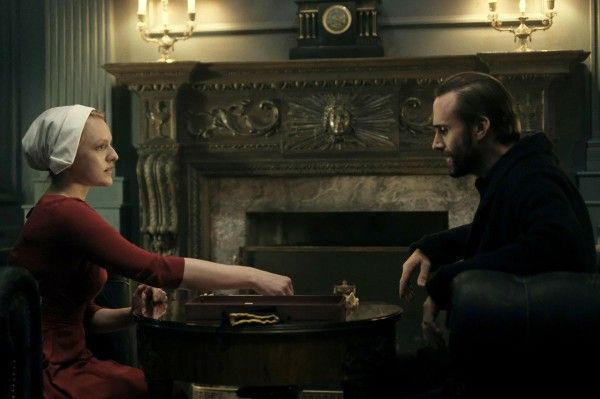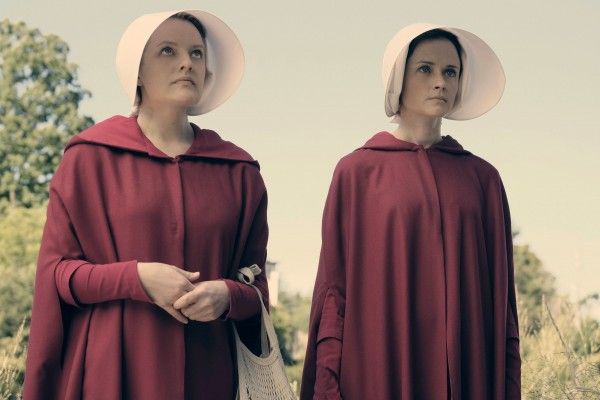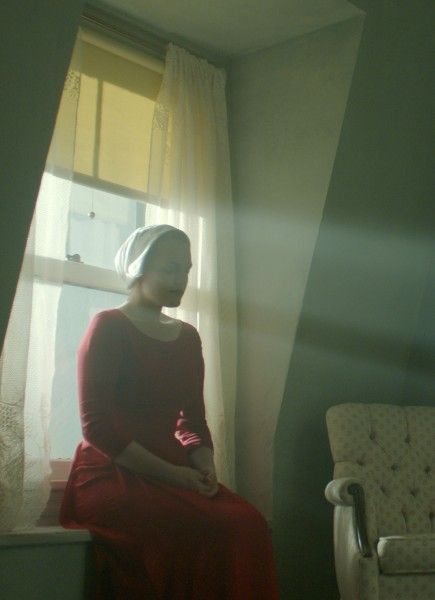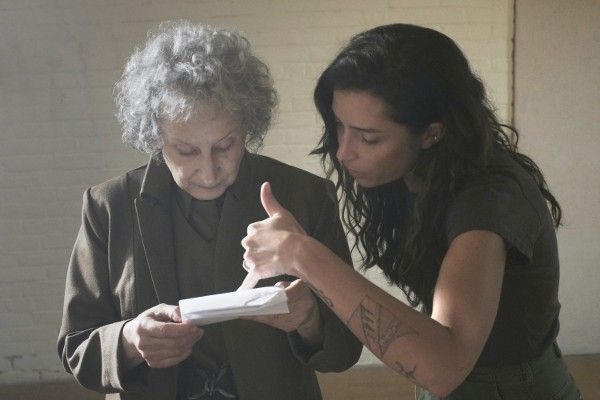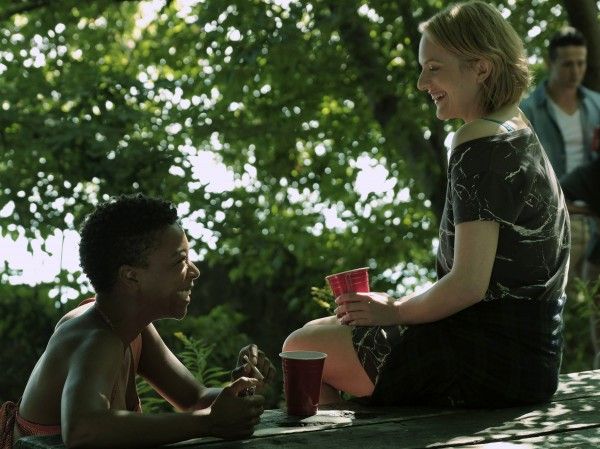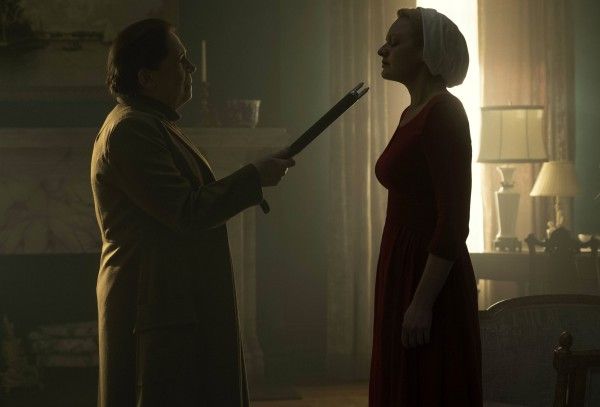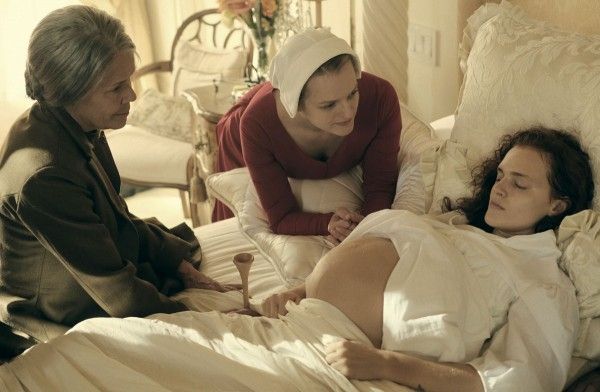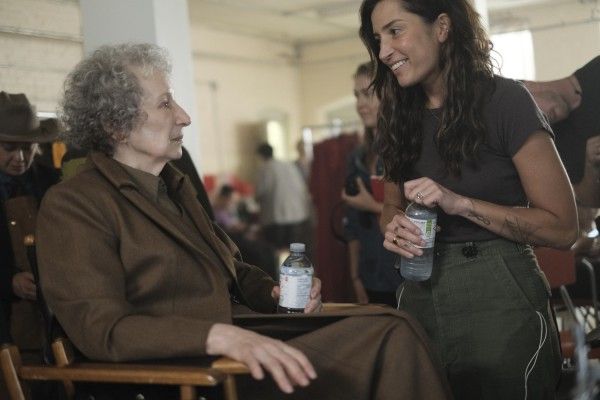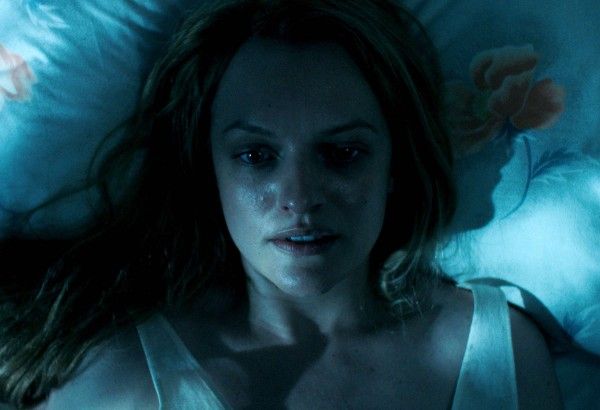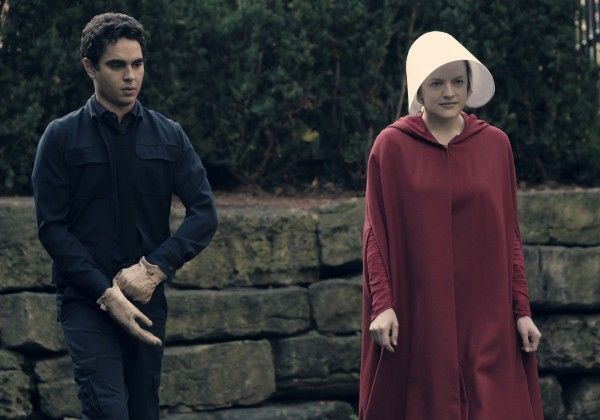What's it like to watch your dystopian nightmare come true? In a word, surreal. Reed Morano can tell you a little bit about that. As the director behind the first three episodes of The Handmaid's Tale, Hulu's acclaimed adaptation of Margaret Atwood's novel of the same name, Morano played a key role in crafting the sumptuous, staggering cinematic language that translates the essential work of dystopian literature to the screen.
Set in a fundamentalist totalitarian post-America where women are reduced to housekeepers, wives and human broodmares, The Handmaid's Tale stars Mad Men breakout Elizabeth Moss in another bravura performance as Offred, a modern woman navigating her newfound role in the oppressive society. Adapted for the screen by series creator Bruce Miller, The Handmaid's Tale not only shows us the horrors of that violent oppression, captured through Morano's poetic, striking imagery, it offers terrifying glimpses at the fall of American society, the proverbial frog in a slow boiling pot.
Translating the story to screen meant including modern updates to the material, some of which have become a bit too recognizable in a time when American politics are more divisive and combustible than most of us can recall in our lifetime. Take for instance the Women's March that followed the election. The Handmaid's Tale completed filming before the ballots were cast, which made it especially unnerving when their inclusion of an ill-fated protest seemed to hold up a semi-prophetic dark mirror to the world. Are we living in The Handmaid’s Tale? No, but it sure does feel like the water might be starting to boil.
I recently hopped on the phone for an interview with Morano to talk about reimagining Atwood's terrifying, timely world for the screen and the strange experience of launching the show in such politically torn climate. An experienced filmmaker with over 50 credits as a cinematographer, including The Skeleton Twins and Kill Your Darlings, Morano recently moved into directing with her feature debut Meadowland, working directing episodes of Showtime’s Billions and AMC’s Halt and Catch Fire, before cementing her status as a talent to watch with The Handmaid’s Tale. As such, Morano has plenty of insight to offer on the technical process of crafting a dystopian nightmare. From her approach to sound design, creating a visual palette for the show, and her cheeky song choices, Morano and I dug into the details behind one of the year's best television shows. Read the full interview below.
So, I have to say, it's the craziest thing to be talking to you about this subject today, when the American House voted in a plan that would make rape and preganacy pre-existing conditions. It's utterly surreal to be talking about this story right now.
REED MORANO: Yeah. This whole thing is so weird. Especially today. It's pretty insane.
Obviously, Margaret Atwood's story's been around a long time and you guys filmed this before the election. So, what has the been like for you, sort of watching bits of it manifest in reality? In particular, what was it like watching the Women's March happen after you guys had filmed your, albeit more disturbing, version?
MORANO: It was really surreal because we didn't know. None of us, obviously, the day after the election, I was in the editing room, basically looked at the assembly of episodes two and three. So, we had already come that far, and everything was way more -- While we were doing that scene, the protest scene, I was like, "I wonder what they would chant. I wonder what the signs would say." You know? And a month later, I would know that. It was very surreal. And then also with just watching the assembly that morning after was, kind of, like everything was -- stuff that had weight before was just way crazier.
Yeah. It's intense to watch right now, for sure. And sorry, I did not mean to start this on a totally political note, but while I was waiting for your call, I was just sitting here spinning out on Twitter.
MORANO: [Laughs] I mean, you can't help it. Honestly, I had another call earlier today and it was totally... every question was political.
Well, to get into the filmmaking. Female directors are, sadly, rare still, but female cinematographers are even more so. Can you talk about how you forged a path into that career? What would be your advice to young women who want to do the same?
MORANO: Well, I just didn't really know when I started. I didn't really realize it was a thing. I didn't realize, and I guess naively, I didn't think gender mattered. So, when I went onto [my] first set, I saw what the DP was doing and I was like, "Wow." I went to school for other stuff and just watched the DP and I was like, "Everything he is seeing, the audience is gonna see through his eyes. I want to be that guy."
So, I didn't really think about, "I'm taking a hard path." You know? And I think, actually part of the problem is people get a little too hung up on like, "I'm a girl and people think I shouldn't be doing this." No, you're thinking you shouldn't be doing this. Don't think about it. So, that's the biggest thing I would say. Also, this is a perfect time to be doing it because right now is the environment for supporting females in the industry. It's not a myth. It's really the best time to be a woman. And instead, it can be an advantage. Think about what you can bring to the table, what you have to offer that makes you unique.
I'm a little obsessed with the book, The Handmaid's Tale. It's been such a huge part of my life. Margaret Atwood wrote a very visual and emotional description of her dystopia, and you guys translated that to screen in a stunning way. How did you approach taking what she gave you on the page and creating the cinematic language for it?
MORANO: Well, I think she basically was very internal. For me, the whole story is really internal. And there are things that are, sort of, visually, that she indicates. For example, the colors that everyone wears and the graphic nature of that. That kind of color segregation is really compelling to look at cinematically. That was the first thing, but also that she creates this internal world where we're in her head. The way that we wanted to do it was sort of inspired by her creating this super internal world, because all the choices for how to cover -- for me, for how to cover the scene, or how to cover flashbacks, or how to cover what lights to use for Offred and what camera movement for Offred... It all was emotionally driven, not driven by style. You know what I mean? So, every choice we made was driven by the emotions of the world that, what situations that Margaret set up in the book or that Bruce wrote into the script. So, if she is being questioned and there's two authority figures in the room -- it just depends on the situation and that was how we chose how we were gonna visually represent it. And when she sets up a world that's already, as I said, the color segregation, you already know you have the opportunity to make something really graphic and not arbitrary.
So, there is sort of a rigidity to the look of Gilead and that the colors you choose. Are they complimentary colors even though they're the opposites? The blue and red. We ended up going different. There was a movie that was made about The Handmaid's Tale. And I never watched it on purpose because I didn't want to ... I just didn't want to know. You know?
Yeah, for sure.
MORANO: And I didn't. But I had seen shots from it and I knew that they had chosen primary red and royal blue, like a primary blue. And not shooting on film, knowing we were shooting on digital. You know, it's like Margaret set it up so that we could have these colors, so I was gonna bring my sensibility to the colors and interpret it. One of the color combos that I really love is the tones of technicolor, which older movies would have, these tones of blue and red in them. This particular blue always reminded me of a peacock blue. And the red was always, kind of like, a very blood red, maybe bordering a little bit on magenta. So, we were trying to get those two colors, basically. That was what I suggested to the team. And then we looking into all different shades with Ane Crabtree, our costume designer. With Colin Watkinson, my DP, to try to make sure that the colors would render correctly in all different kinds of light. And there was going to be a lot of shadow and light. Everything like that was very thought out, but it was great to have that guide, the guide of the book.
As far as the way we shot Gilead and those very strict compositions, that just kind of went with the feeling I got from what the world is described as being. The world is described as being so unsettling. And there is something unsettling about strictly symmetrical things, to me. Or one that's slightly off, because we kind of did both. Then the flashbacks, I felt like, I don't like to do really gimmicky things with flashbacks, not change the color or anything. But it was like, what do the flashbacks mean, emotionally, to the character. And I just said, "Well, it's like their memory, their fleeting memory. So, how do we visualize the fleeting memory?" And it felt like the way to do that would be to shoot them, not with standard coverage, not picking up everybody's line. Like, almost a verite kind of impression of the camera.
Well, that's so cool. I'm excited to re-watch and pay attention to that. Something else that's very striking to me about the series is that is as much as it's very disturbing and sort of heart-rending to watch, it's also incredibly good entertainment. It's propulsive. You want to get to the next episode. Can you talk about walking that line? It's a difficult tonal balance.
MORANO: Well, thanks for saying that because that's the perfect response. It was really a thing we had a lot of discussions about because it's like, obviously the book is super dark. However, it's not devoid of satire. You know? Margaret has a sense of humor and I know Bruce and all of us, and Hulu and Warren and myself and Lizzy, we all wanted to retain that sense of cheekiness that the narrator has a little bit. Not cheekiness. Sort of just like irreverence of certain things. And also, now, when you take a woman, nowadays, in the present day, and if it were to god forbid happen to them, they would be reacting like they do. Not being prim and proper about it. You know? In your head, you feel like, "What the fuck is this?"
Absolutely.
MORANO: So, to have that ability, it really helps. Normally if I would read in a script that there's mostly flashbacks and mostly voiceover, I would run as far away as possible. [Laughs] But because I knew the book, I knew that this was gonna be -- It's the way you tell the story. So, it doesn't feel heavy-handed because it's just, it is the story. That's how the story's told.
It helped to have the flashbacks to take you -- to give you a breather from the weight of Gilead, but also some of the flashbacks you get into are even heavier than Gilead. You know? So, it's a back and forth kind of thing, but at least it changes up the environment and I think that helps. Changing the environment, in a world like that, and being able to escape to another part of "why did this happen" or "here's another clue", it helps make it more compelling and not what you get. You know, you never get too comfortable in a moment there. Because even if we let one long scene play out in a one-er, you know that you're gonna go someplace else probably completely different right after that. That helps. And I think also, like I said, the sense of humor that Bruce instilled in the writing. I think it enabled Lizzy to play with that. And even the capability of the things that the handmaids can do because of the wings that they wear, their bonnet, they are able to express themselves explicitly in the confines of the wings when no one's facing that. Because nobody can see.
Oh, good point.
MORANO: So, we have that capability to kind of allow a little more expressiveness in that face that you never normally would see. And then also, I just felt like musically, I sort of made the decision early on in my head, I didn't know where modern music was gonna go 100%, but I, kind of, felt like it was justified to be music that they would have heard before pre-Gilead. Like, it could be in her head, because there could be music that's modern in Gilead, only if it's part of her emotional state. So, something that Offred had heard and grown up with, and something that represented a feeling she was feeling.
And then as far as the ability to go into flashbacks, you get to change up completely the sound design. We were very specific that there's only certain noises, certain sounds you'd hear in Gilead and the sounds are so limited. Then when you go into a flashback it's like a cacophony of sound, like what we hear now. It's almost like an assault of sound. With that, I often would try to bring in, if when appropriate, a song that you would never hear in Gilead. I think just being able to use all these tools we had in our tool bag, we were able to make sure that the show never gets -- It's oppressive, but it never gets so oppressive that you don't want to watch it anymore. Ideally, that would be our goal. Because it's like your morbid curiosity. You just want to, kind of, see what happens next.
Absolutely. So, I was trying to only watch the first three episodes, but I had access to all of them, and I accidentally watched them all, which I didn't mean to do. So I would say you guys succeeded.
MORANO: That's ... awesome [laughs].
Yeah. So, obviously the was just renewed for a second season, and I did read that you were asked to come back. Is that something that you guys are already in development on?
MORANO: I do think that they have started the writer's room.
Nice.
MORANO: So, they're working on it. And it's going forward. So, it's definitely coming back.
Do you want to come back for season two? Are you still working that out?
MORANO: Yeah. I mean, I told them that I would love to. It's really more of matter of scheduling and stuff where I would come back. Like, what part of the season I come back in because I'm directing another film in October.
So, okay. I made it pretty clear I'm a fan of what you did on the show. This, show and those first three episodes, in particular, are so strong. You should be having one of those breakout moments where you're on the top of the studio and network lists. Is that happening for you? Are you having a Noah Hawley post Fargo moment? What have the last few weeks been like for you?
MORANO: Yeah. It's been a bit crazy. I just literally wrapped a movie, like three days ago.
Oh, wow.
MORANO: And we picked up the tail end of it, here in LA. So, I was already here and my agents have a lot of meetings set up for me, suffice to say. There's some cool possibilities, I think, out there. Yeah. It's definitely ... It's the craziest thing. It's been the craziest time for me, for sure. Like 100%. I can't even really believe it's happening.
I can only imagine. Do you have an idea of a general direction you'd like to go with your career? Are you looking to make big blockbuster films or are you taking more on a project by project basis?
MORANO: I'm thinking more on a project by project basis. I don't wanna only do one thing. The only prerequisite it whatever it is, big or small, that I can bring something to the table that makes it special. I don't want to come in and do something that's been done before. You know, for me it's not that I wouldn't come in and do a sequel to something, but it's only if I can bring something new to the table and I'm not following an extremely strict path. So, I guess I would say it's about just how great of a story and is there an opportunity to create real interesting depth of character.
Right. Yeah, you can look at the dystopian genre and you can find real trash, but you look at Margaret Atwood, and that's something very different. Not that... Look, I love dystopian fiction and I'm not trying to be haughty, but you picked a good one for sure.
MORANO: Yeah. You can't go wrong with that one.
So I'm just about out of time with you, but tell me a little about the film you just wrapped. Is this the one with Peter Dinklage and Elle Fanning?
MORANO: Yeah. We just wrapped up. That's the one that I just wrapped. I'm about to go into the edit on it. It's called, I Think We're Alone Now. Yeah. I think it's gonna be interesting. Very different than Handmaid's Tale and very different than the next thing I do. So, very special. You know, it's a post-apocalyptic film, basically. Peter's character thinks he's the last man on earth and he is for a while, until someone else comes along. And that's Elle Fanning. It's actually just more of a story about human connection than it is about the apocalypse, for example, it just happens to be set against a very bizarre backdrop.


